DEV-5002A: Quantitative Evidence Report on Climate Change, Norwich
VerifiedAdded on 2023/05/28
|9
|2681
|394
Report
AI Summary
This quantitative evidence report examines the effects of climate change in the East of England, with a specific focus on Norwich. The report begins with an introduction to the region and its vulnerability to climate change, emphasizing the importance of understanding these changes for sustainable living and economic stability. The literature review explores existing research on the topic, highlighting man-made landscapes, water scarcity, and the risks associated with flooding and rising sea levels, supported by data on rainfall and emissions. The report then presents quantitative data analysis, exploring research questions on individual motivations for climate change initiatives, voting preferences, and student support for climate policies. Data collected shows the impact on tourism and rising UK emissions. Interpretation of graphical data details the threats from temperature extremes, flooding, and pollution, including their effects on mortality rates and health. The report concludes by synthesizing these findings to provide a comprehensive overview of climate change impacts and the need for strategic measures to mitigate these effects.

Running head; QUANTITATIVE EVIDENCE REPORT 1
Quantitative Evidence Report
Name
Institution
Tutor
Date
Quantitative Evidence Report
Name
Institution
Tutor
Date
Paraphrase This Document
Need a fresh take? Get an instant paraphrase of this document with our AI Paraphraser
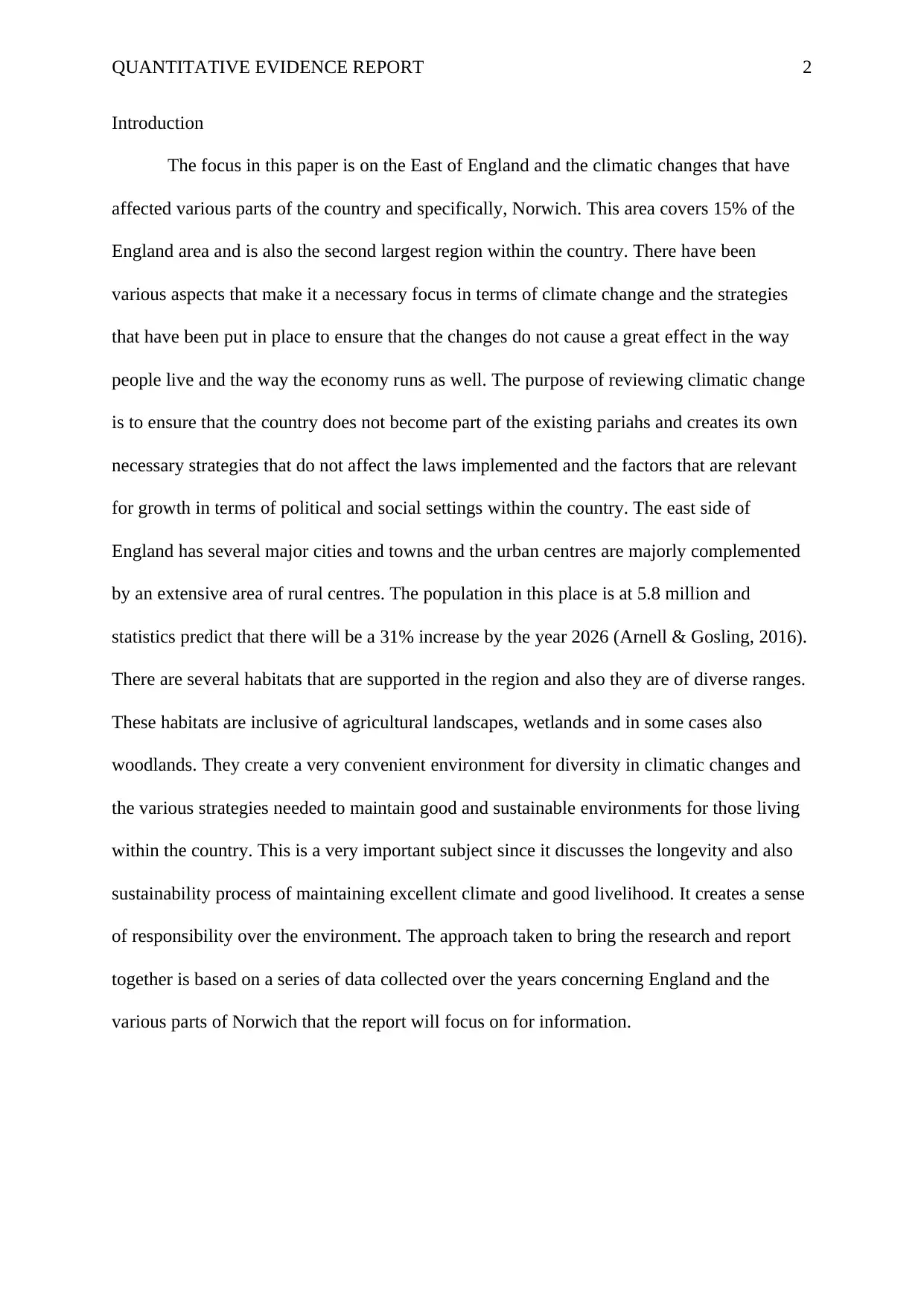
QUANTITATIVE EVIDENCE REPORT 2
Introduction
The focus in this paper is on the East of England and the climatic changes that have
affected various parts of the country and specifically, Norwich. This area covers 15% of the
England area and is also the second largest region within the country. There have been
various aspects that make it a necessary focus in terms of climate change and the strategies
that have been put in place to ensure that the changes do not cause a great effect in the way
people live and the way the economy runs as well. The purpose of reviewing climatic change
is to ensure that the country does not become part of the existing pariahs and creates its own
necessary strategies that do not affect the laws implemented and the factors that are relevant
for growth in terms of political and social settings within the country. The east side of
England has several major cities and towns and the urban centres are majorly complemented
by an extensive area of rural centres. The population in this place is at 5.8 million and
statistics predict that there will be a 31% increase by the year 2026 (Arnell & Gosling, 2016).
There are several habitats that are supported in the region and also they are of diverse ranges.
These habitats are inclusive of agricultural landscapes, wetlands and in some cases also
woodlands. They create a very convenient environment for diversity in climatic changes and
the various strategies needed to maintain good and sustainable environments for those living
within the country. This is a very important subject since it discusses the longevity and also
sustainability process of maintaining excellent climate and good livelihood. It creates a sense
of responsibility over the environment. The approach taken to bring the research and report
together is based on a series of data collected over the years concerning England and the
various parts of Norwich that the report will focus on for information.
Introduction
The focus in this paper is on the East of England and the climatic changes that have
affected various parts of the country and specifically, Norwich. This area covers 15% of the
England area and is also the second largest region within the country. There have been
various aspects that make it a necessary focus in terms of climate change and the strategies
that have been put in place to ensure that the changes do not cause a great effect in the way
people live and the way the economy runs as well. The purpose of reviewing climatic change
is to ensure that the country does not become part of the existing pariahs and creates its own
necessary strategies that do not affect the laws implemented and the factors that are relevant
for growth in terms of political and social settings within the country. The east side of
England has several major cities and towns and the urban centres are majorly complemented
by an extensive area of rural centres. The population in this place is at 5.8 million and
statistics predict that there will be a 31% increase by the year 2026 (Arnell & Gosling, 2016).
There are several habitats that are supported in the region and also they are of diverse ranges.
These habitats are inclusive of agricultural landscapes, wetlands and in some cases also
woodlands. They create a very convenient environment for diversity in climatic changes and
the various strategies needed to maintain good and sustainable environments for those living
within the country. This is a very important subject since it discusses the longevity and also
sustainability process of maintaining excellent climate and good livelihood. It creates a sense
of responsibility over the environment. The approach taken to bring the research and report
together is based on a series of data collected over the years concerning England and the
various parts of Norwich that the report will focus on for information.

QUANTITATIVE EVIDENCE REPORT 3
Literature Review
There are several findings concerning the general set up on the East Side of England.
The first and most relevant is that the landscape is not entirely natural. Most of the region’s
landscape is manmade and takes up a large amount of the rural setting where the conservation
strategies are more efficient and reliable. The reason why this is the case is due to the
reclamation of land in the United Kingdom from the sea in an effort to bring to existence the
Fens (Kuklicke & Demeritt, 2016). The grade 1 and grade 2 lands are mostly owned by the
Fens which are also good agricultural lands and are not distributed more commonly
compared to the rest of the land. The climate changes come with several risks that require
mitigating which is why most of the land is definitively separated in an effort to maintain
certain good qualities. The risks are associated with the normal activities that result from
climate change. The aspect of climate change has a great effect if not well managed and
looked into by various responsible people. The quantitative research design used brings out
several findings that affect the way in which conservation, political and social activities may
contribute to climate change.
According to Cai et al, (2014), the first effect of climate change is water scarcity
which also affects the various conservation plans and strategies that are set apart on a daily
and annual basis. The East England Region is evidently the driest region in the country and
has a low amount of rainfall based on annual measurements. The average amount of rainfall
is at 60mm which is not enough to sustain certain agricultural land and may be of a huge
effect to the way climate change is handled throughout the country. The Lake district in
comparison to this region gives off more rainfall than that of the dry region. There are
significant water challenges faced in the region which means that most of the records show
the overly abstracted region in terms of low-flows. There is always damage which happens at
the areas with the low flows and it takes a certain amount of strategic rectifications to ensure
Literature Review
There are several findings concerning the general set up on the East Side of England.
The first and most relevant is that the landscape is not entirely natural. Most of the region’s
landscape is manmade and takes up a large amount of the rural setting where the conservation
strategies are more efficient and reliable. The reason why this is the case is due to the
reclamation of land in the United Kingdom from the sea in an effort to bring to existence the
Fens (Kuklicke & Demeritt, 2016). The grade 1 and grade 2 lands are mostly owned by the
Fens which are also good agricultural lands and are not distributed more commonly
compared to the rest of the land. The climate changes come with several risks that require
mitigating which is why most of the land is definitively separated in an effort to maintain
certain good qualities. The risks are associated with the normal activities that result from
climate change. The aspect of climate change has a great effect if not well managed and
looked into by various responsible people. The quantitative research design used brings out
several findings that affect the way in which conservation, political and social activities may
contribute to climate change.
According to Cai et al, (2014), the first effect of climate change is water scarcity
which also affects the various conservation plans and strategies that are set apart on a daily
and annual basis. The East England Region is evidently the driest region in the country and
has a low amount of rainfall based on annual measurements. The average amount of rainfall
is at 60mm which is not enough to sustain certain agricultural land and may be of a huge
effect to the way climate change is handled throughout the country. The Lake district in
comparison to this region gives off more rainfall than that of the dry region. There are
significant water challenges faced in the region which means that most of the records show
the overly abstracted region in terms of low-flows. There is always damage which happens at
the areas with the low flows and it takes a certain amount of strategic rectifications to ensure
⊘ This is a preview!⊘
Do you want full access?
Subscribe today to unlock all pages.

Trusted by 1+ million students worldwide

QUANTITATIVE EVIDENCE REPORT 4
that the same does not affect the climate patterns for another period of time. There are
resources provided for these areas and in most cases, they do not operate above the
designated target headroom which makes it difficult to maintain strategic measures on certain
levels altogether. The transfers made greatly affect the maintenance of water supplies and are
very useful in the provision of support in agriculture and the whole of the water environment.
The water resource management structure in Norwich has taken a turn in that there are
particularly very specific respects placed on the high levels of planned growth and also the
extent by which wetlands and other water dependent habitats are looked at and maintained.
The water resources are always under pressure from the industrial sector whose
interests fall on agri-businesses and a culture that focuses on the development of the
environment through creation of sustainable cycles. The flooding in Norwich affects a great
number of properties and also extends to other towns and cities that are a part of the Eastern
region in England (Jones et al, 2016). This climatic change mostly interrupts the processes in
households and several non-residential areas which makes it difficult to maintain a certain
level of sustainable strategies. The low lying area is greatly affected along with the critical
infrastructure that is within the area. Norwich however has not been recorded as having a
great number of properties at risk in comparison to areas such as Norfolk. Besides this, the
sea level rise is one other climatic hardship that has affected a great area and shows more
consistency in the low lying areas within the East of England. 20% of the Eastern region lies
below sea level and gets affected in several instances. The high UKCP09 emissions have put
the region at risk of experiencing very high increases in seal level. This however is mitigated
by some plans based on the Shoreline management strategies in order to reduce and beat the
probability by a very high percentage. The plans also include a series of the best scientific
knowledge plans and the latest developments that create the same plans.
that the same does not affect the climate patterns for another period of time. There are
resources provided for these areas and in most cases, they do not operate above the
designated target headroom which makes it difficult to maintain strategic measures on certain
levels altogether. The transfers made greatly affect the maintenance of water supplies and are
very useful in the provision of support in agriculture and the whole of the water environment.
The water resource management structure in Norwich has taken a turn in that there are
particularly very specific respects placed on the high levels of planned growth and also the
extent by which wetlands and other water dependent habitats are looked at and maintained.
The water resources are always under pressure from the industrial sector whose
interests fall on agri-businesses and a culture that focuses on the development of the
environment through creation of sustainable cycles. The flooding in Norwich affects a great
number of properties and also extends to other towns and cities that are a part of the Eastern
region in England (Jones et al, 2016). This climatic change mostly interrupts the processes in
households and several non-residential areas which makes it difficult to maintain a certain
level of sustainable strategies. The low lying area is greatly affected along with the critical
infrastructure that is within the area. Norwich however has not been recorded as having a
great number of properties at risk in comparison to areas such as Norfolk. Besides this, the
sea level rise is one other climatic hardship that has affected a great area and shows more
consistency in the low lying areas within the East of England. 20% of the Eastern region lies
below sea level and gets affected in several instances. The high UKCP09 emissions have put
the region at risk of experiencing very high increases in seal level. This however is mitigated
by some plans based on the Shoreline management strategies in order to reduce and beat the
probability by a very high percentage. The plans also include a series of the best scientific
knowledge plans and the latest developments that create the same plans.
Paraphrase This Document
Need a fresh take? Get an instant paraphrase of this document with our AI Paraphraser
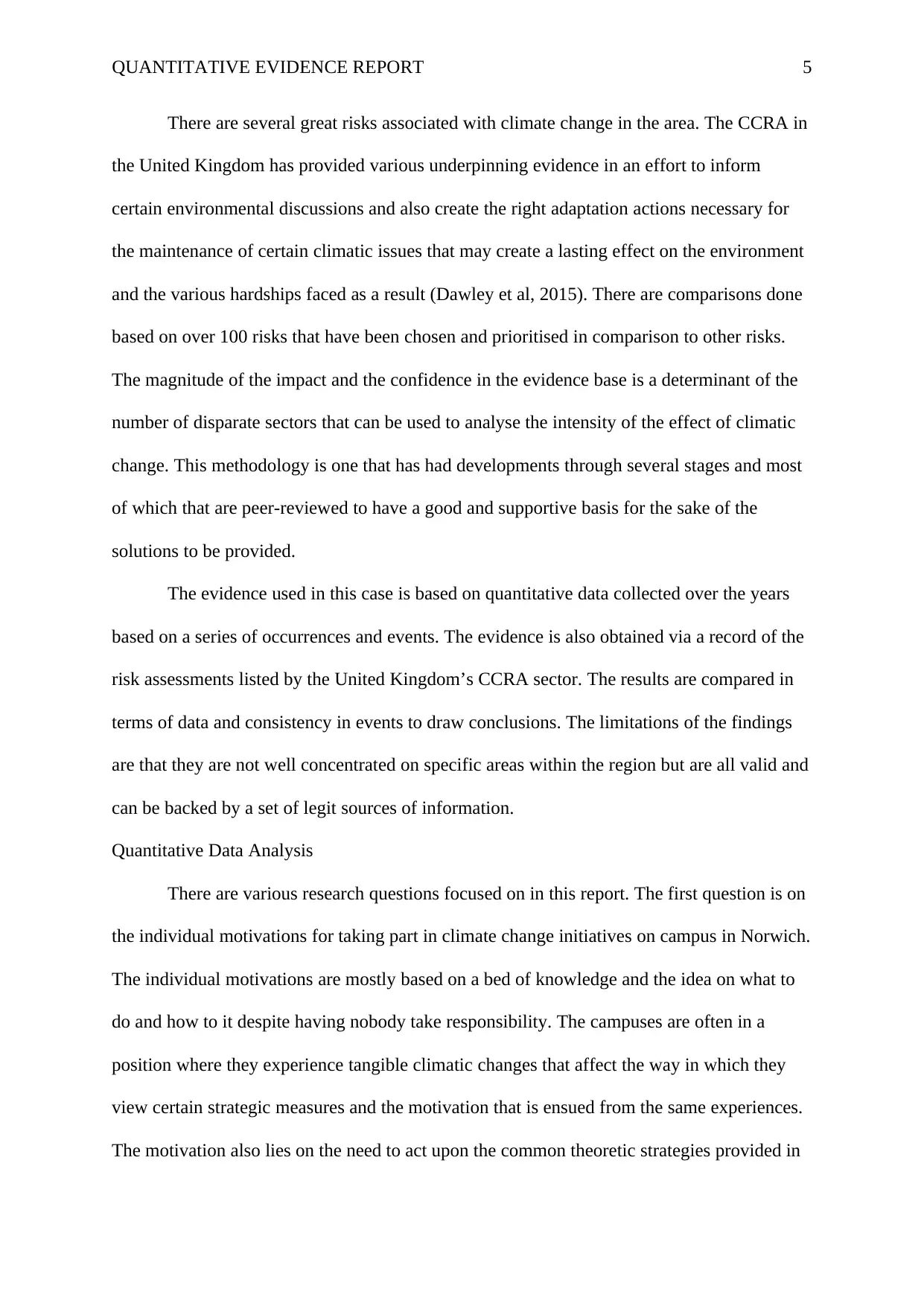
QUANTITATIVE EVIDENCE REPORT 5
There are several great risks associated with climate change in the area. The CCRA in
the United Kingdom has provided various underpinning evidence in an effort to inform
certain environmental discussions and also create the right adaptation actions necessary for
the maintenance of certain climatic issues that may create a lasting effect on the environment
and the various hardships faced as a result (Dawley et al, 2015). There are comparisons done
based on over 100 risks that have been chosen and prioritised in comparison to other risks.
The magnitude of the impact and the confidence in the evidence base is a determinant of the
number of disparate sectors that can be used to analyse the intensity of the effect of climatic
change. This methodology is one that has had developments through several stages and most
of which that are peer-reviewed to have a good and supportive basis for the sake of the
solutions to be provided.
The evidence used in this case is based on quantitative data collected over the years
based on a series of occurrences and events. The evidence is also obtained via a record of the
risk assessments listed by the United Kingdom’s CCRA sector. The results are compared in
terms of data and consistency in events to draw conclusions. The limitations of the findings
are that they are not well concentrated on specific areas within the region but are all valid and
can be backed by a set of legit sources of information.
Quantitative Data Analysis
There are various research questions focused on in this report. The first question is on
the individual motivations for taking part in climate change initiatives on campus in Norwich.
The individual motivations are mostly based on a bed of knowledge and the idea on what to
do and how to it despite having nobody take responsibility. The campuses are often in a
position where they experience tangible climatic changes that affect the way in which they
view certain strategic measures and the motivation that is ensued from the same experiences.
The motivation also lies on the need to act upon the common theoretic strategies provided in
There are several great risks associated with climate change in the area. The CCRA in
the United Kingdom has provided various underpinning evidence in an effort to inform
certain environmental discussions and also create the right adaptation actions necessary for
the maintenance of certain climatic issues that may create a lasting effect on the environment
and the various hardships faced as a result (Dawley et al, 2015). There are comparisons done
based on over 100 risks that have been chosen and prioritised in comparison to other risks.
The magnitude of the impact and the confidence in the evidence base is a determinant of the
number of disparate sectors that can be used to analyse the intensity of the effect of climatic
change. This methodology is one that has had developments through several stages and most
of which that are peer-reviewed to have a good and supportive basis for the sake of the
solutions to be provided.
The evidence used in this case is based on quantitative data collected over the years
based on a series of occurrences and events. The evidence is also obtained via a record of the
risk assessments listed by the United Kingdom’s CCRA sector. The results are compared in
terms of data and consistency in events to draw conclusions. The limitations of the findings
are that they are not well concentrated on specific areas within the region but are all valid and
can be backed by a set of legit sources of information.
Quantitative Data Analysis
There are various research questions focused on in this report. The first question is on
the individual motivations for taking part in climate change initiatives on campus in Norwich.
The individual motivations are mostly based on a bed of knowledge and the idea on what to
do and how to it despite having nobody take responsibility. The campuses are often in a
position where they experience tangible climatic changes that affect the way in which they
view certain strategic measures and the motivation that is ensued from the same experiences.
The motivation also lies on the need to act upon the common theoretic strategies provided in
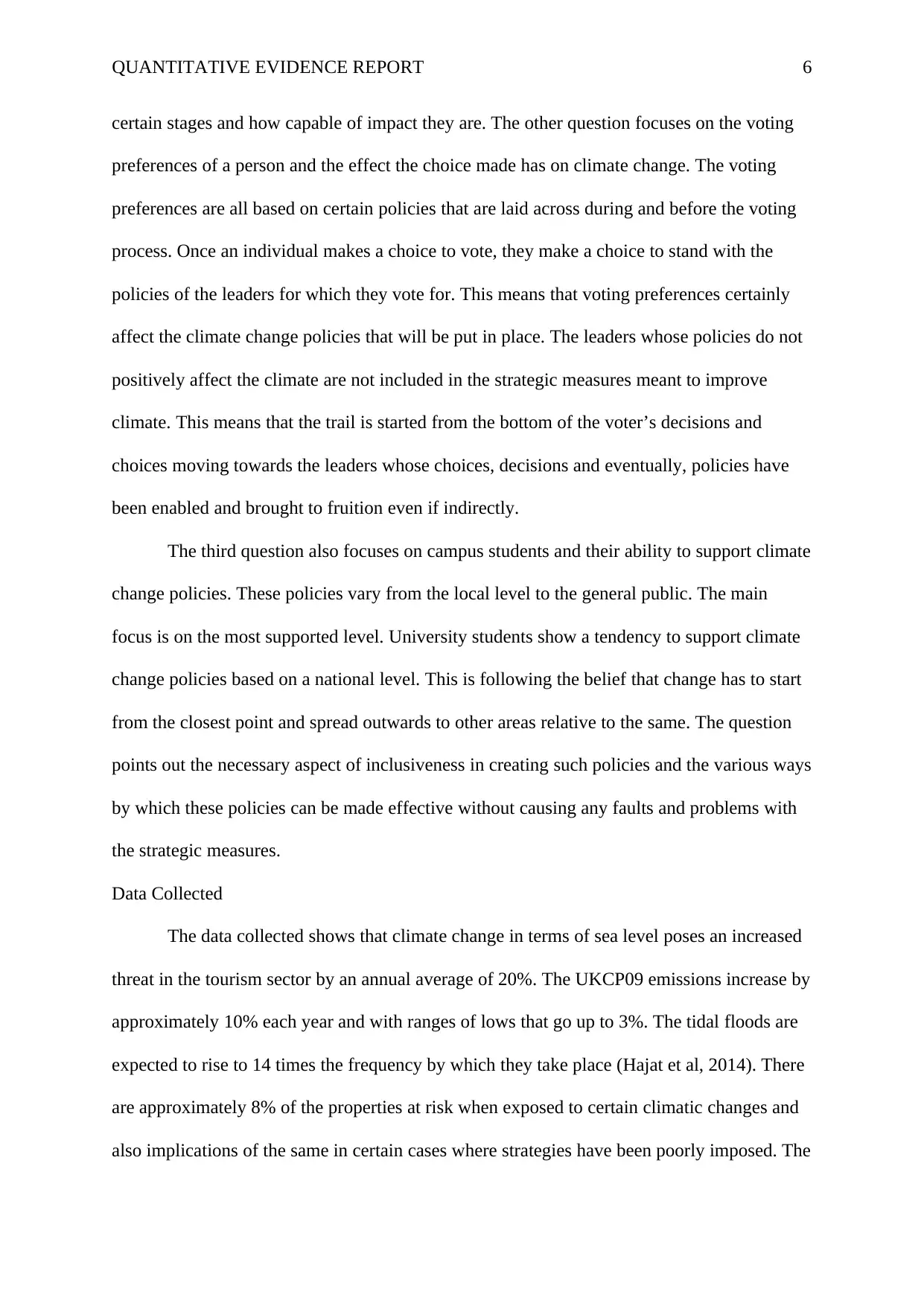
QUANTITATIVE EVIDENCE REPORT 6
certain stages and how capable of impact they are. The other question focuses on the voting
preferences of a person and the effect the choice made has on climate change. The voting
preferences are all based on certain policies that are laid across during and before the voting
process. Once an individual makes a choice to vote, they make a choice to stand with the
policies of the leaders for which they vote for. This means that voting preferences certainly
affect the climate change policies that will be put in place. The leaders whose policies do not
positively affect the climate are not included in the strategic measures meant to improve
climate. This means that the trail is started from the bottom of the voter’s decisions and
choices moving towards the leaders whose choices, decisions and eventually, policies have
been enabled and brought to fruition even if indirectly.
The third question also focuses on campus students and their ability to support climate
change policies. These policies vary from the local level to the general public. The main
focus is on the most supported level. University students show a tendency to support climate
change policies based on a national level. This is following the belief that change has to start
from the closest point and spread outwards to other areas relative to the same. The question
points out the necessary aspect of inclusiveness in creating such policies and the various ways
by which these policies can be made effective without causing any faults and problems with
the strategic measures.
Data Collected
The data collected shows that climate change in terms of sea level poses an increased
threat in the tourism sector by an annual average of 20%. The UKCP09 emissions increase by
approximately 10% each year and with ranges of lows that go up to 3%. The tidal floods are
expected to rise to 14 times the frequency by which they take place (Hajat et al, 2014). There
are approximately 8% of the properties at risk when exposed to certain climatic changes and
also implications of the same in certain cases where strategies have been poorly imposed. The
certain stages and how capable of impact they are. The other question focuses on the voting
preferences of a person and the effect the choice made has on climate change. The voting
preferences are all based on certain policies that are laid across during and before the voting
process. Once an individual makes a choice to vote, they make a choice to stand with the
policies of the leaders for which they vote for. This means that voting preferences certainly
affect the climate change policies that will be put in place. The leaders whose policies do not
positively affect the climate are not included in the strategic measures meant to improve
climate. This means that the trail is started from the bottom of the voter’s decisions and
choices moving towards the leaders whose choices, decisions and eventually, policies have
been enabled and brought to fruition even if indirectly.
The third question also focuses on campus students and their ability to support climate
change policies. These policies vary from the local level to the general public. The main
focus is on the most supported level. University students show a tendency to support climate
change policies based on a national level. This is following the belief that change has to start
from the closest point and spread outwards to other areas relative to the same. The question
points out the necessary aspect of inclusiveness in creating such policies and the various ways
by which these policies can be made effective without causing any faults and problems with
the strategic measures.
Data Collected
The data collected shows that climate change in terms of sea level poses an increased
threat in the tourism sector by an annual average of 20%. The UKCP09 emissions increase by
approximately 10% each year and with ranges of lows that go up to 3%. The tidal floods are
expected to rise to 14 times the frequency by which they take place (Hajat et al, 2014). There
are approximately 8% of the properties at risk when exposed to certain climatic changes and
also implications of the same in certain cases where strategies have been poorly imposed. The
⊘ This is a preview!⊘
Do you want full access?
Subscribe today to unlock all pages.

Trusted by 1+ million students worldwide
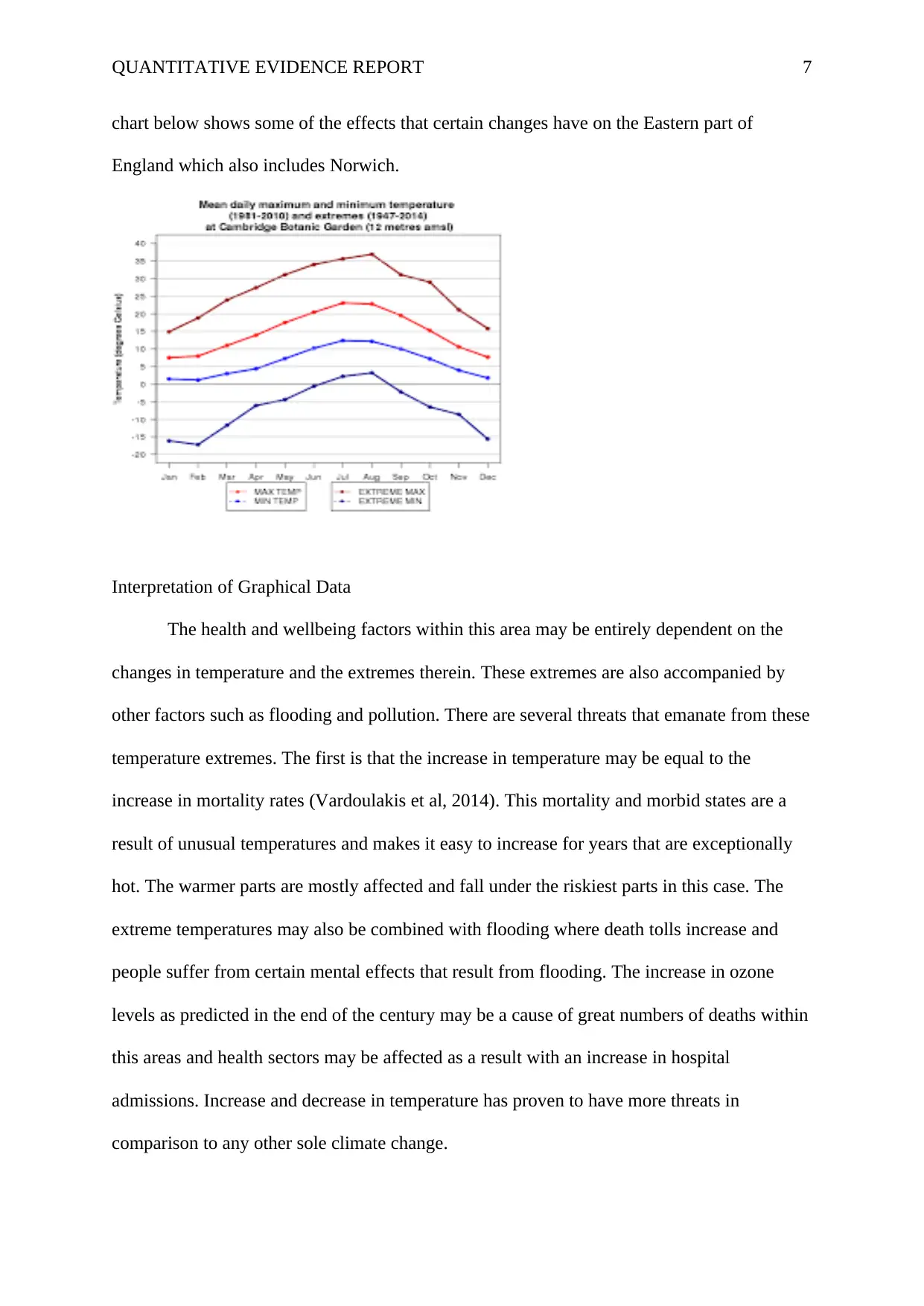
QUANTITATIVE EVIDENCE REPORT 7
chart below shows some of the effects that certain changes have on the Eastern part of
England which also includes Norwich.
Interpretation of Graphical Data
The health and wellbeing factors within this area may be entirely dependent on the
changes in temperature and the extremes therein. These extremes are also accompanied by
other factors such as flooding and pollution. There are several threats that emanate from these
temperature extremes. The first is that the increase in temperature may be equal to the
increase in mortality rates (Vardoulakis et al, 2014). This mortality and morbid states are a
result of unusual temperatures and makes it easy to increase for years that are exceptionally
hot. The warmer parts are mostly affected and fall under the riskiest parts in this case. The
extreme temperatures may also be combined with flooding where death tolls increase and
people suffer from certain mental effects that result from flooding. The increase in ozone
levels as predicted in the end of the century may be a cause of great numbers of deaths within
this areas and health sectors may be affected as a result with an increase in hospital
admissions. Increase and decrease in temperature has proven to have more threats in
comparison to any other sole climate change.
chart below shows some of the effects that certain changes have on the Eastern part of
England which also includes Norwich.
Interpretation of Graphical Data
The health and wellbeing factors within this area may be entirely dependent on the
changes in temperature and the extremes therein. These extremes are also accompanied by
other factors such as flooding and pollution. There are several threats that emanate from these
temperature extremes. The first is that the increase in temperature may be equal to the
increase in mortality rates (Vardoulakis et al, 2014). This mortality and morbid states are a
result of unusual temperatures and makes it easy to increase for years that are exceptionally
hot. The warmer parts are mostly affected and fall under the riskiest parts in this case. The
extreme temperatures may also be combined with flooding where death tolls increase and
people suffer from certain mental effects that result from flooding. The increase in ozone
levels as predicted in the end of the century may be a cause of great numbers of deaths within
this areas and health sectors may be affected as a result with an increase in hospital
admissions. Increase and decrease in temperature has proven to have more threats in
comparison to any other sole climate change.
Paraphrase This Document
Need a fresh take? Get an instant paraphrase of this document with our AI Paraphraser
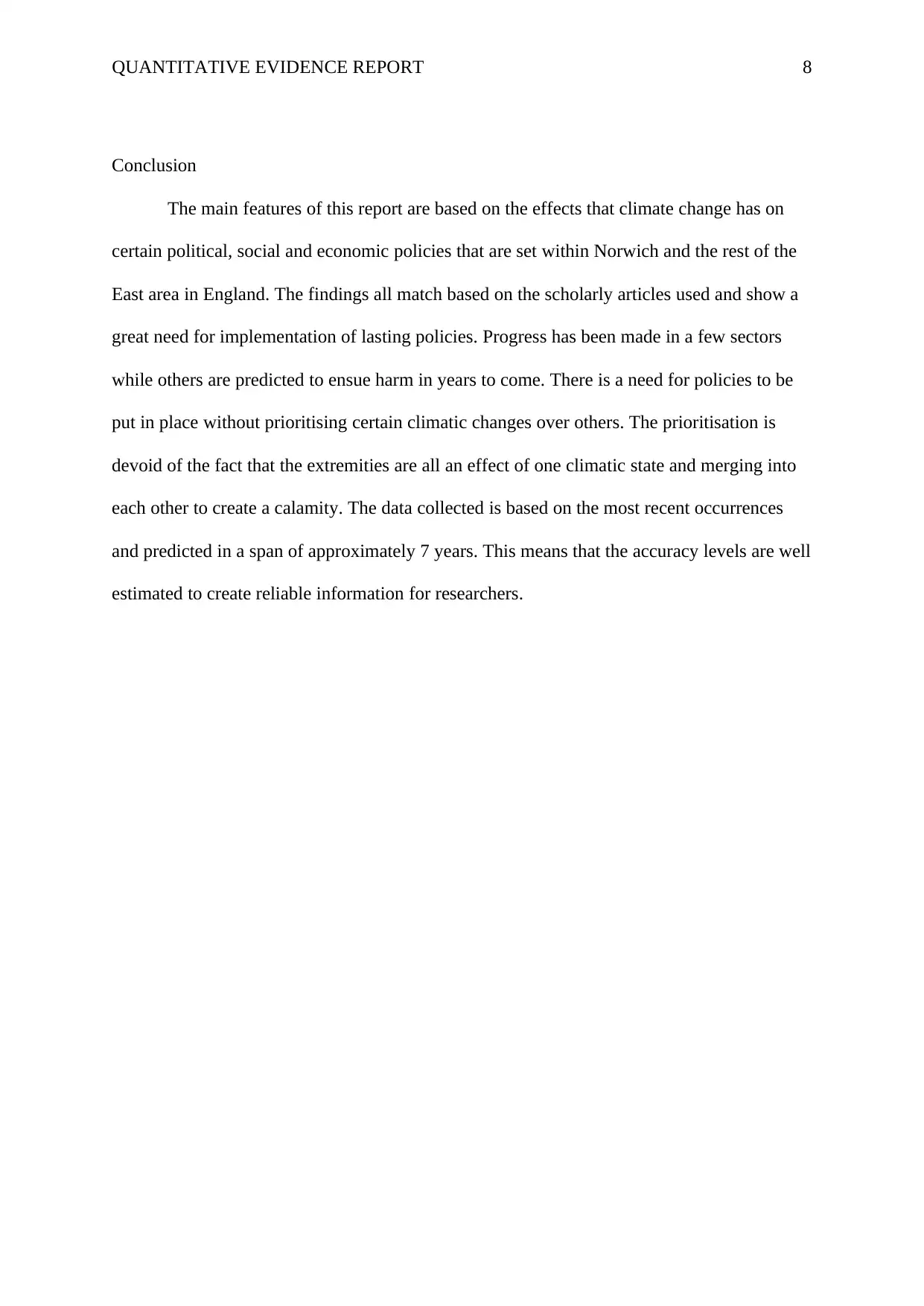
QUANTITATIVE EVIDENCE REPORT 8
Conclusion
The main features of this report are based on the effects that climate change has on
certain political, social and economic policies that are set within Norwich and the rest of the
East area in England. The findings all match based on the scholarly articles used and show a
great need for implementation of lasting policies. Progress has been made in a few sectors
while others are predicted to ensue harm in years to come. There is a need for policies to be
put in place without prioritising certain climatic changes over others. The prioritisation is
devoid of the fact that the extremities are all an effect of one climatic state and merging into
each other to create a calamity. The data collected is based on the most recent occurrences
and predicted in a span of approximately 7 years. This means that the accuracy levels are well
estimated to create reliable information for researchers.
Conclusion
The main features of this report are based on the effects that climate change has on
certain political, social and economic policies that are set within Norwich and the rest of the
East area in England. The findings all match based on the scholarly articles used and show a
great need for implementation of lasting policies. Progress has been made in a few sectors
while others are predicted to ensue harm in years to come. There is a need for policies to be
put in place without prioritising certain climatic changes over others. The prioritisation is
devoid of the fact that the extremities are all an effect of one climatic state and merging into
each other to create a calamity. The data collected is based on the most recent occurrences
and predicted in a span of approximately 7 years. This means that the accuracy levels are well
estimated to create reliable information for researchers.
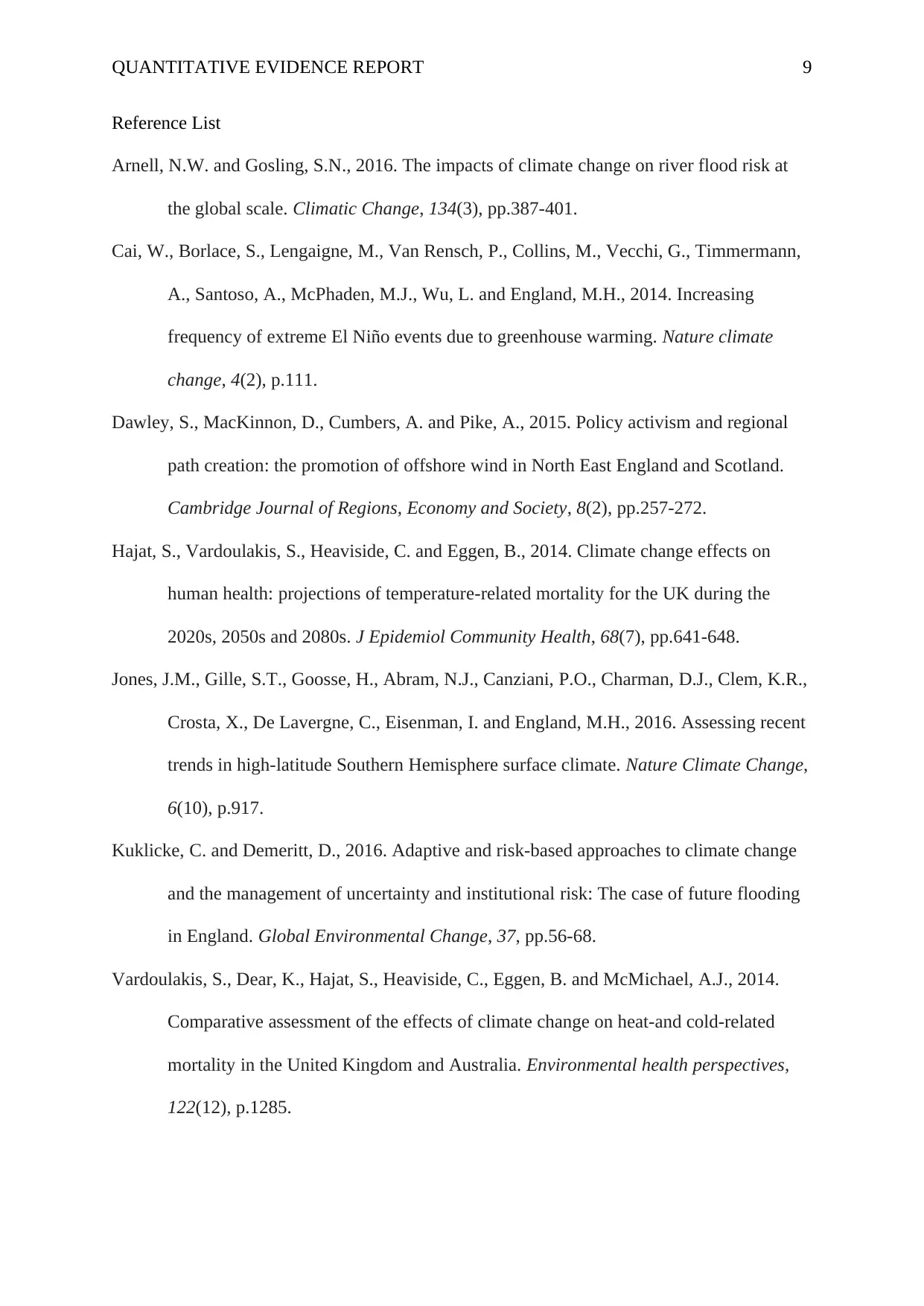
QUANTITATIVE EVIDENCE REPORT 9
Reference List
Arnell, N.W. and Gosling, S.N., 2016. The impacts of climate change on river flood risk at
the global scale. Climatic Change, 134(3), pp.387-401.
Cai, W., Borlace, S., Lengaigne, M., Van Rensch, P., Collins, M., Vecchi, G., Timmermann,
A., Santoso, A., McPhaden, M.J., Wu, L. and England, M.H., 2014. Increasing
frequency of extreme El Niño events due to greenhouse warming. Nature climate
change, 4(2), p.111.
Dawley, S., MacKinnon, D., Cumbers, A. and Pike, A., 2015. Policy activism and regional
path creation: the promotion of offshore wind in North East England and Scotland.
Cambridge Journal of Regions, Economy and Society, 8(2), pp.257-272.
Hajat, S., Vardoulakis, S., Heaviside, C. and Eggen, B., 2014. Climate change effects on
human health: projections of temperature-related mortality for the UK during the
2020s, 2050s and 2080s. J Epidemiol Community Health, 68(7), pp.641-648.
Jones, J.M., Gille, S.T., Goosse, H., Abram, N.J., Canziani, P.O., Charman, D.J., Clem, K.R.,
Crosta, X., De Lavergne, C., Eisenman, I. and England, M.H., 2016. Assessing recent
trends in high-latitude Southern Hemisphere surface climate. Nature Climate Change,
6(10), p.917.
Kuklicke, C. and Demeritt, D., 2016. Adaptive and risk-based approaches to climate change
and the management of uncertainty and institutional risk: The case of future flooding
in England. Global Environmental Change, 37, pp.56-68.
Vardoulakis, S., Dear, K., Hajat, S., Heaviside, C., Eggen, B. and McMichael, A.J., 2014.
Comparative assessment of the effects of climate change on heat-and cold-related
mortality in the United Kingdom and Australia. Environmental health perspectives,
122(12), p.1285.
Reference List
Arnell, N.W. and Gosling, S.N., 2016. The impacts of climate change on river flood risk at
the global scale. Climatic Change, 134(3), pp.387-401.
Cai, W., Borlace, S., Lengaigne, M., Van Rensch, P., Collins, M., Vecchi, G., Timmermann,
A., Santoso, A., McPhaden, M.J., Wu, L. and England, M.H., 2014. Increasing
frequency of extreme El Niño events due to greenhouse warming. Nature climate
change, 4(2), p.111.
Dawley, S., MacKinnon, D., Cumbers, A. and Pike, A., 2015. Policy activism and regional
path creation: the promotion of offshore wind in North East England and Scotland.
Cambridge Journal of Regions, Economy and Society, 8(2), pp.257-272.
Hajat, S., Vardoulakis, S., Heaviside, C. and Eggen, B., 2014. Climate change effects on
human health: projections of temperature-related mortality for the UK during the
2020s, 2050s and 2080s. J Epidemiol Community Health, 68(7), pp.641-648.
Jones, J.M., Gille, S.T., Goosse, H., Abram, N.J., Canziani, P.O., Charman, D.J., Clem, K.R.,
Crosta, X., De Lavergne, C., Eisenman, I. and England, M.H., 2016. Assessing recent
trends in high-latitude Southern Hemisphere surface climate. Nature Climate Change,
6(10), p.917.
Kuklicke, C. and Demeritt, D., 2016. Adaptive and risk-based approaches to climate change
and the management of uncertainty and institutional risk: The case of future flooding
in England. Global Environmental Change, 37, pp.56-68.
Vardoulakis, S., Dear, K., Hajat, S., Heaviside, C., Eggen, B. and McMichael, A.J., 2014.
Comparative assessment of the effects of climate change on heat-and cold-related
mortality in the United Kingdom and Australia. Environmental health perspectives,
122(12), p.1285.
⊘ This is a preview!⊘
Do you want full access?
Subscribe today to unlock all pages.

Trusted by 1+ million students worldwide
1 out of 9
Your All-in-One AI-Powered Toolkit for Academic Success.
+13062052269
info@desklib.com
Available 24*7 on WhatsApp / Email
![[object Object]](/_next/static/media/star-bottom.7253800d.svg)
Unlock your academic potential
Copyright © 2020–2025 A2Z Services. All Rights Reserved. Developed and managed by ZUCOL.
